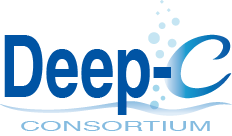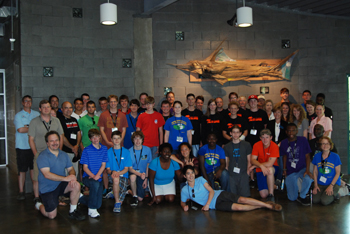2014 Deep-C ROV Competition Showcases Students’ Talent and Ingenuity
Underwater robots ROVing the Dauphin Island Sea Lab's campus
|
|
Reprinted from the May 2014 issue of DISL Sea Lab Skimmer Newsletter - Discovery Hall Programs hosted the 2nd Annual Deep-C ROV competition for high school students the weekend of April 25-27. ROVs (Remotely Operated Vehicles) are underwater robots tethered by a cable to a surface controller. They are widely used in ocean exploration, maritime industries and marine science research and range from small inexpensive machines to huge multi-million dollar robots.
Teams of high school students and their teachers came from as far away as Apopka, Florida and Madison, Alabama to pit their ROVs against one another in a series of missions that simulate real world problems in the ocean. Missions included identifying underwater structures, deploying sensors, collecting 'oil' samples, and retrieving items from the 'seafloor.'
Students started the school year designing, building and testing their unique ROV. Some teams used programmable control boards, such as arduinos, in their ROVs, while others used a simple joystick controller. Some used CAD (computer-aided design) programs to develop their designs, while others simply built and rebuilt.
Dr. Tina Miller-Way, Chair of Discovery Hall Programs said, "We saw some very clever use of materials, such as kitchen cutting boards, and some beautifully designed ROVs that did not work well underwater. It's interesting to see how students approach the process: some focus on the design process, while others use the practical approach of building, testing, redesigning, retesting.
|
|
"During the process the students are gaining a firsthand understanding of several physical science principles, learning circuitry and exploring the engineering design process, but they are developing real-life skills and coming to directly appreciate the value of teamwork." After the pool competition, student teams gave a presentation on their design to a panel of engineers, robotics teachers and scientists. article2 Participants in the 2014 Deep-C ROV Competition.
Ms. Rachel Gamble, the ROV Competition Coordinator, indicated the winning teams this year were:
- 1st place - the Subtropics from Santa Rosa Christian School in Milton, FL;
- 2nd place - James S. Rickards High School in Tallahassee; and
- 3rd place - SAIL High School, also in Tallahassee.
James Clemons High School from Madison, AL won the Buoyancy Award for the best attitude in the face of adversity and SAIL High School won the Tethered Together Award for exceptional teamwork.
It wasn't all work during the weekend as students got the chance to take a trip aboard the Sea Lab's research vessel, talk to scientists who use ROVs in their research and team up for an ROV relay race. Discovery Hall Programs would like to thank the many pool volunteers, judges and scientists who assisted, as well as the City of Mobile Swim Association for the use of their pool. We also thank the Deep-C Consortium for their support of the competition.
This year, the Deep-C competition also served as a regional competition site for the MATE program, an international marine technology program (http://www.marinetech.org). MATE's mission is to use marine technology to create interest in and improve STEM education as well as workforce development. The Deep-C Consortium is a group of 10 universities and research institutions that received a $20 million grant from the Gulf of Mexico Research Initiative to conduct research on the impact of the oil spill and do educational outreach. The student ROV competition is one component of their extensive education and outreach program.
The Deep-C (Deep Sea to Coast Connectivity in the Eastern Gulf of Mexico) Consortium is a long-term, interdisciplinary study of deep sea to coast connectivity in the northeastern Gulf of Mexico. The study is investigating the environmental consequences of petroleum hydrocarbon release in the deep Gulf on living marine resources and ecosystem health. Deep-C research is made possible by a grant from BP/The Gulf of Mexico Research Initiative.
 Tina Miller-Way |
Dr. Tina Miller-Way is Chair of Discovery Hall Programs for Education and Outreach at the Dauphin Island Sea Lab (DISL). The lab, located in southern Mobile County off Alabama's Gulf Coast, is well-known for their excellence in education and outreach programming. As a marine laboratory, DISL's mission encompasses marine science education, marine science research, coastal zone management policy and educating the general public through the Estuarium, Dauphin Island Sea Lab's public aquarium. The lab partners with more than 20 colleges and with primary schools to offer marine science coursework up to the graduate level. The research programs of the Dauphin Island Sea Lab range from biogeochemistry and oceanography to systems ecology. Most research focuses on the near-shore and estuarine processes of Mobile Bay, field sites of our internationally-renowned faculty include Mexico, Australia, and Croatia and other countries.
Deep-C was a four-year, interdisciplinary study of deep sea to coast connectivity in the northeastern Gulf of Mexico.Deep-C is no longer an active research project. The information on this website is for historical reference purposes only.
Home | About Us | Research Areas | Data Center | News & Multimedia | Education & Outreach
© Deep-C Consortium. All Rights Reserved.
This research was made possible by a grant fromThe Gulf of Mexico Research Initiative (GoMRI).
Copyright | Disclaimer | Privacy Policy

